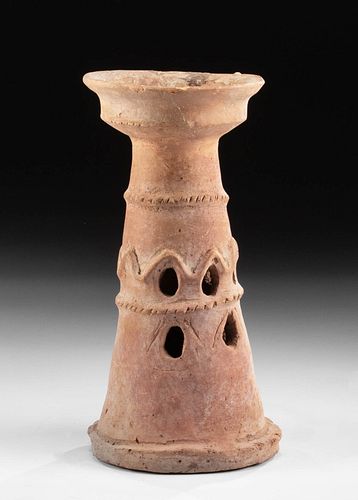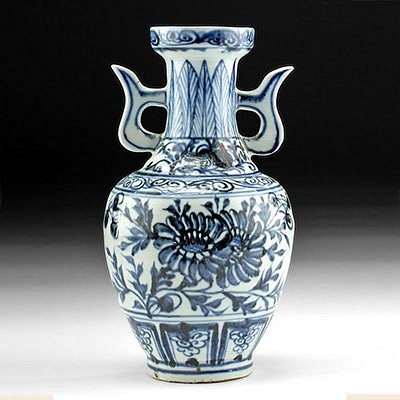Ancient Holy Land Terracotta Incense Burner
Lot 33a
About Seller
Artemis Gallery
686 S Taylor Ave, Ste 106
Louisville, CO 80027
United States
Selling antiquities, ancient and ethnographic art online since 1993, Artemis Gallery specializes in Classical Antiquities (Egyptian, Greek, Roman, Near Eastern), Asian, Pre-Columbian, African / Tribal / Oceanographic art. Our extensive inventory includes pottery, stone, metal, wood, glass and textil...Read more
Categories
Estimate:
$600 - $900
Absentee vs Live bid
Two ways to bid:
- Leave a max absentee bid and the platform will bid on your behalf up to your maximum bid during the live auction.
- Bid live during the auction and your bids will be submitted real-time to the auctioneer.
Bid Increments
| Price | Bid Increment |
|---|---|
| $0 | $25 |
| $300 | $50 |
| $1,000 | $100 |
| $2,000 | $250 |
| $5,000 | $500 |
| $10,000 | $1,000 |
| $20,000 | $2,500 |
| $50,000 | $5,000 |
| $100,000 | $10,000 |
| $200,000 | $20,000 |
About Auction
By Artemis Gallery
Nov 19, 2020
Set Reminder
2020-11-19 10:00:00
2020-11-19 10:00:00
America/New_York
Bidsquare
Bidsquare : Ancient Treasures & Holiday Jewelry
https://www.bidsquare.com/auctions/artemis-gallery/ancient-treasures-holiday-jewelry-6035
Travel around the world and back in time and be amazed at the treasures you will find! Antiquities from Egypt, Greece, Italy and the Near East, Asian, Pre-Columbian, African/Tribal/Oceanic, Native American, Spanish Colonial, Fine Art, much more. Shop early for the holidays! Artemis Gallery info@artemisgallery.com
Travel around the world and back in time and be amazed at the treasures you will find! Antiquities from Egypt, Greece, Italy and the Near East, Asian, Pre-Columbian, African/Tribal/Oceanic, Native American, Spanish Colonial, Fine Art, much more. Shop early for the holidays! Artemis Gallery info@artemisgallery.com
- Lot Description
Ancient Near East, Holy Land, Iron Age II, ca. 800 to 500 BCE. A hand-built terracotta incense burner meant to be placed atop a vessel filled with smoldering incense. The hollow body exhibits a conical form with seven perforations along the front to allow incense smoke to escape, and a shallow top cup creates a secondary area for incense to be burnt. Segmented bands are applied both above and below a zigzagging central bar for decorative purposes and to enable its owner to sufficiently grip the surfaces. Size: 5.6" W x 11.2" H (14.2 cm x 28.4 cm)
Provenance: private Orange County, California, USA collection; ex-Sands of Time Ancient Art, Washington, D.C., USA; ex-The Hauge Collection of Ancient & Iranian Art, assembled between 1962 and 1966. Foreign service brothers, Victor and Osborne Hauge, together with their wives Takako and Gratia, assembled their collection of Persian, Japanese, Chinese, and Southeast Asian works of fine and fold art while stationed overseas with the US government after WWII. In consultation with academics and dealers, the Hauges assembled over two decades of what former Freer Gallery Art director Harold Stern described in 1957 as "without doubt one of the finest private collections in the world." Victor and Takako published Folk Traditions in Japanese Art to coincide with a traveling exhibition held from 1978 at the Cleveland Museum of Art; Japan House Gallery, New York; and Asian Art Museum, San Francisco. Much of their collection was donated to the Freer Gallery of Art and Arthur M. Sackler Gallery at the Smithsonian Institute culminating in an exhibition and published catalogue in 2000. The balance of the collection, including this object, was inherited by descent in 2016.
All items legal to buy/sell under U.S. Statute covering cultural patrimony Code 2600, CHAPTER 14, and are guaranteed to be as described or your money back.
A Certificate of Authenticity will accompany all winning bids.
We ship worldwide and handle all shipping in-house for your convenience.
#156875Repaired from multiple pieces, with resurfacing and overpainting along break lines, and light adhesive residue in some areas. Nicks and abrasions to base, body, and rim, with light fading to original pigment, and scattered encrustations. Nice earthen deposits throughout.Condition
- Shipping Info
-
All shipping is handled in-house for your convenience. Your invoice from Artemis Gallery will include shipping calculation instructions. If in doubt, please inquire BEFORE bidding for estimated shipping costs for individual items.
-
- Buyer's Premium



 EUR
EUR CAD
CAD AUD
AUD GBP
GBP MXN
MXN HKD
HKD CNY
CNY MYR
MYR SEK
SEK SGD
SGD CHF
CHF THB
THB
















